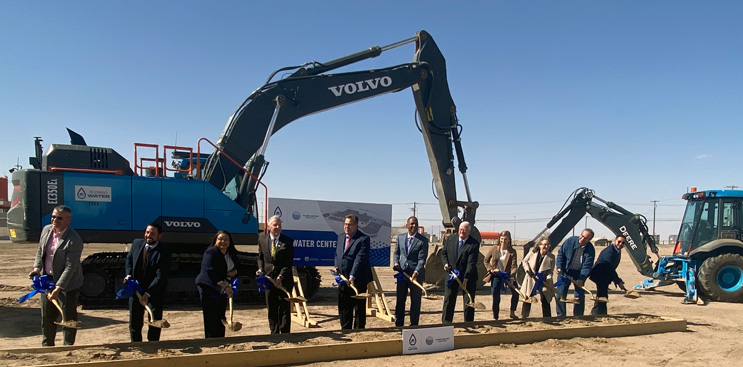Future of Water Reuse Forum Draws Proficient Water Experts
By Martha C. Koester, El Paso Water

With a mass of industry professionals in town for a historic groundbreaking, El Paso Water seized the opportunity to host the Future of Water Reuse Forum and contemplate the future of water supply.
On Feb. 27, over 100 water industry professionals — local, state, national and international — as well as community leaders helped EPWater break ground on the trailblazing Pure Water Center. The new plant will transform treated wastewater into fresh drinking water. In the industry’s most sophisticated development in water reuse yet, the plant will send purified drinking water straight into El Paso’s water distribution system.
“We are proud to lead the way to a more sustainable water future for both El Pasoans and communities across the nation,” said Gilbert Trejo, Vice President of Operations and Technical Services at EPWater.
Water Reuse As A Solution
Before the forum, Trejo encouraged the 100 participants to gain a better understanding of the challenges and opportunities of water reuse and its role in the future of water supply.
Moderator Eva Steinle-Darling, Carollo Engineers’ Water Reuse Technical Practice Director, asked the first panelists what challenges water reuse will solve.
EPWater’s Wastewater Systems Division Manager Angel Bustamante called attention to dwindling water systems, along with rivers and lakes.
“We are all trying to make sure that we provide safe drinking water for our communities and our customers,” Bustamante said. “Reuse is that next step, and it’s the way of the future.”
Former Public Service Board member Dr. Kristina Mena, El Paso Campus Dean of the UTHealth Houston School of Public Health, said the reuse industry can help communities understand what is in their wastewater, such as viruses. Mena’s university has led several studies into El Paso’s wastewater monitoring for public health.
“The industry could be at the forefront of stakeholder communication,” Mena said. “There is so much the water reuse industry can help in terms of public health.”
Regulatory challenges were also a hot topic.
“Sometimes it’s not possible for a laboratory to meet a requirement because we don’t have the technology to come up with data to compare,” Mena said. “Also, it’s the mere fact that some of these organisms can be difficult to grow or culture in high enough numbers to show the law of reduction.”
Experts also considered the need for transparency and the potential for real-time monitoring of water quality.
“This is a perfect opportunity because technology has been advancing on potable reuse or water recycling,” said Dr. Lauren Kennedy, Assistant Professor of Civil Engineering at the University of Texas at El Paso. “As projects like the Pure Water Center become more common in the U.S., the industry might consider online drinking water distribution system monitoring because it can help people see their own water quality.”
Kennedy praised El Paso’s water quality and development of future water supply.
“We are lucky in El Paso that we have great water,” Kennedy said. “I have worked with the water that will come out of the Pure Water Center, and it’s amazing. This is very advanced, and it’s exciting to bring that source into our water supply portfolios.”
On The Horizon
Moderator and consultant Guy Carpenter prompted the second panel to consider the future of water reuse in the next 50 years.
“As far as providing water, what is happening in El Paso is going to be the model for over 50 years,” said David LaFrance, CEO of American Water Works Association. “It is going to be customized for what each utility needs and dependent on what their water supplies are, what growth is, and the type of communities they are serving.”
“We will see more regions across the country build reuse into their water portfolio,” said Pat Sinicropi, Executive Director of the WateReuse Association. “We will see more direct potable reuse systems because of the scarcity challenges. In some regions, you will see a growth of industrial water reuse, and agriculture water reuse will become more prevalent across the Midwest.”
The conversation also turned to financing water reuse projects, apart from relying on government grants and loans.
“Everything that Gilbert Trejo and El Paso Water, and Wichita Falls has done has all been based on research,” said Daniel Nix, Executive Director of the Texas American Water Works Association. “Research provided by research foundations and academia is driven by grants and funding. If we want reuse to continue, that funding has to continue for research or it will stagnate.”
Experts also considered the reluctance of a few communities to embrace water reuse as a drinking water supply, even as groundwater supply dwindles.
“It will depend on forward-thinking utility leaders to ask communities to have this conversation about water reuse,” Sinicropi said. “You cannot build these reuse systems in two to three years. It takes 10 to 15 years of design and communicating with ratepayers.”
As industry regulations focus on new emerging contaminants in water, all agreed that water quality research is essential.
“I think it will force more research and make us more conscientious of being better stewards of our environment,” Sinicropi said.
“I have watched every single one of these contaminants make their scene on the stage, and the water industry and research has stepped up and overcome each and continue to protect public health,” Nix said.
Martha C. Koester is Lead Public Affairs Coordinator for El Paso Water. She is a veteran newspaper journalist for more than 25 years.
